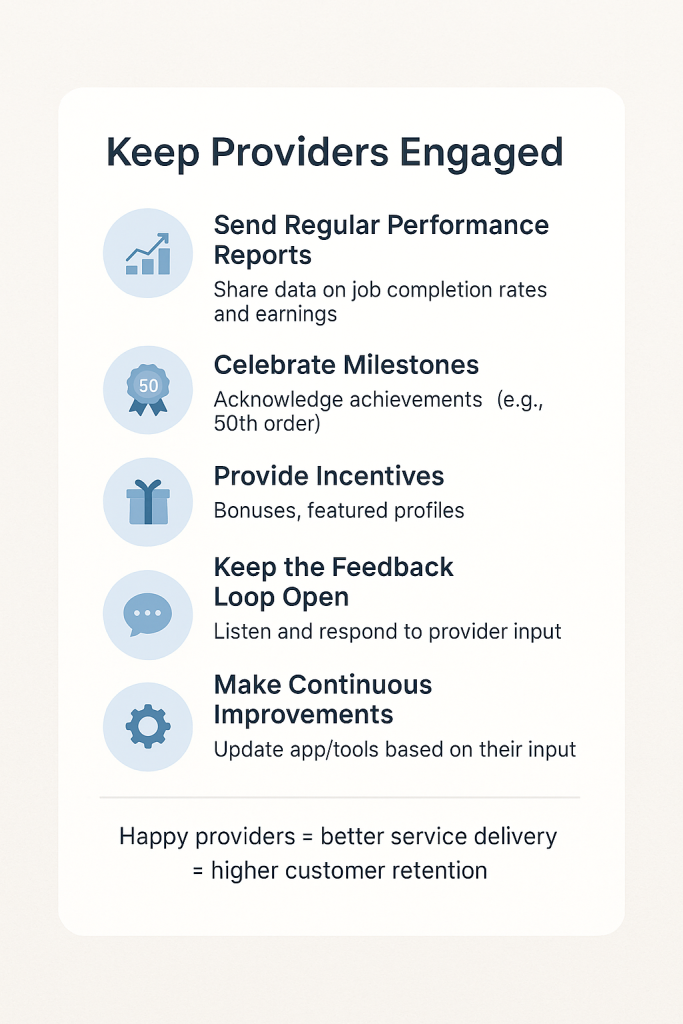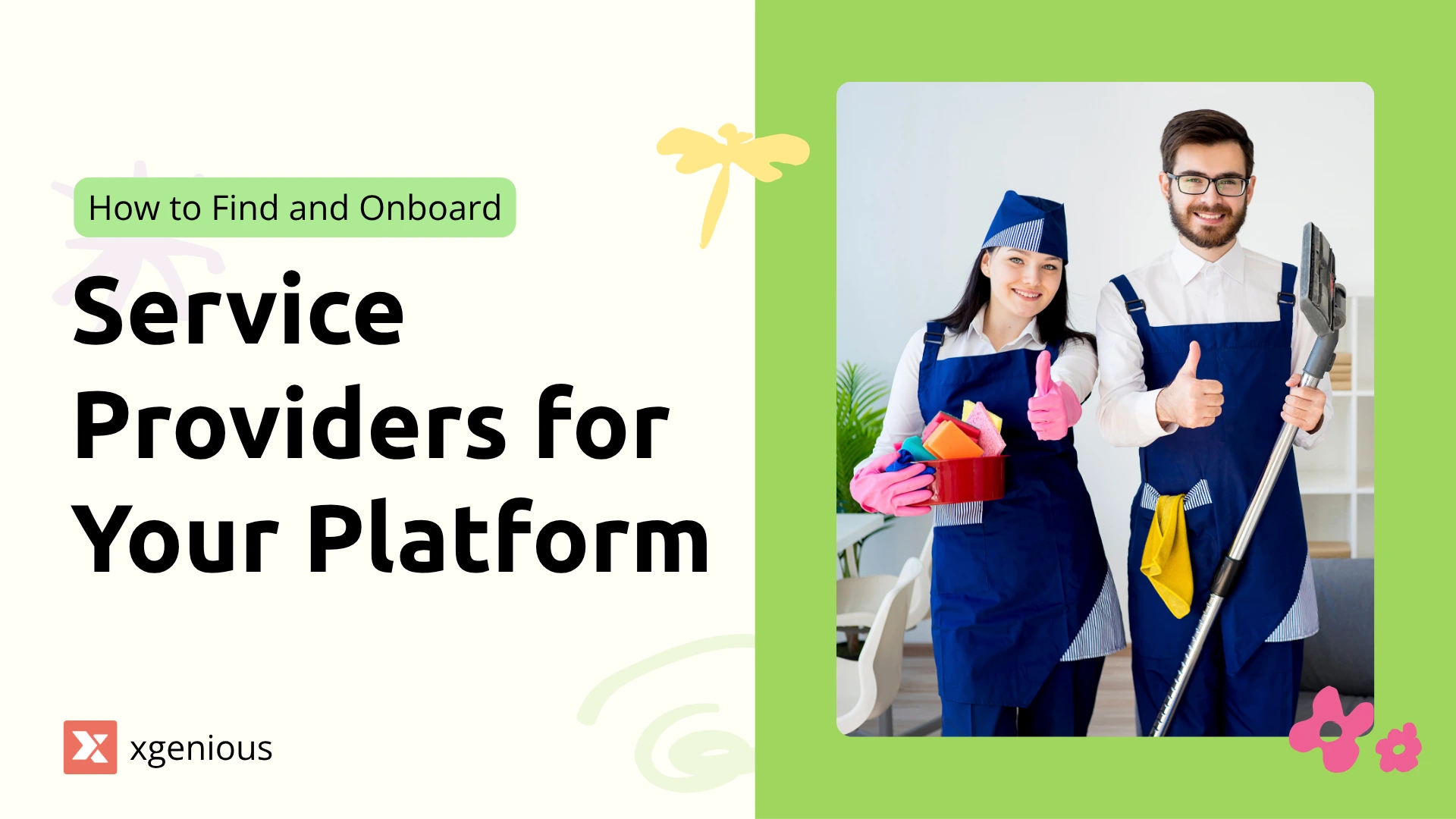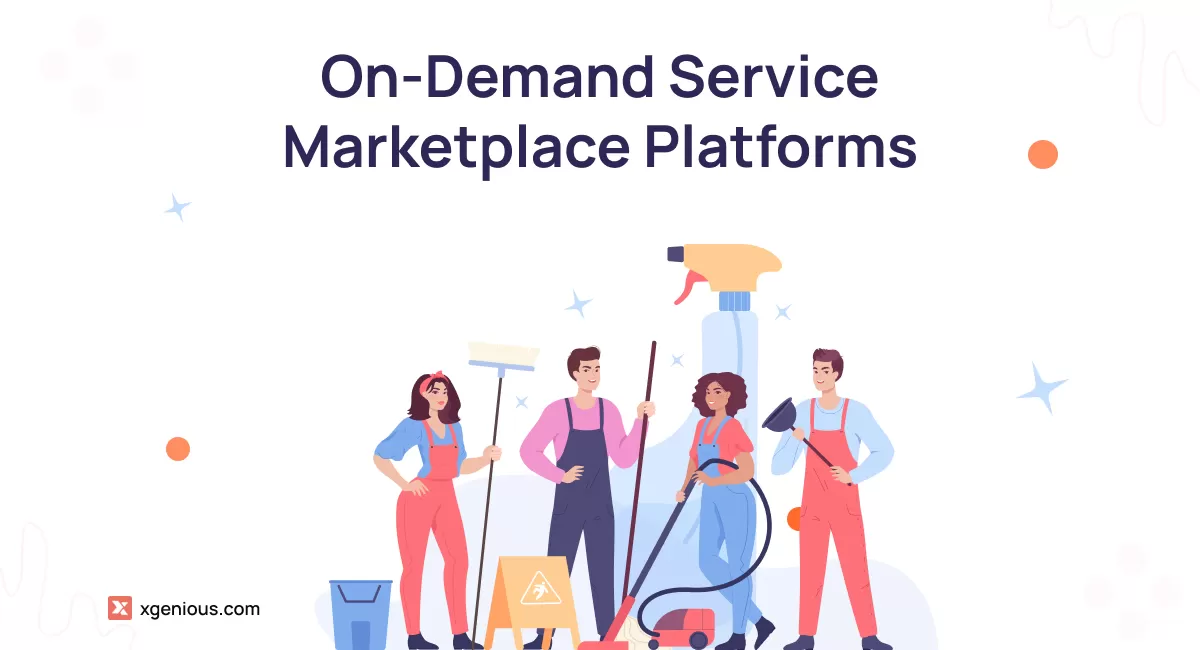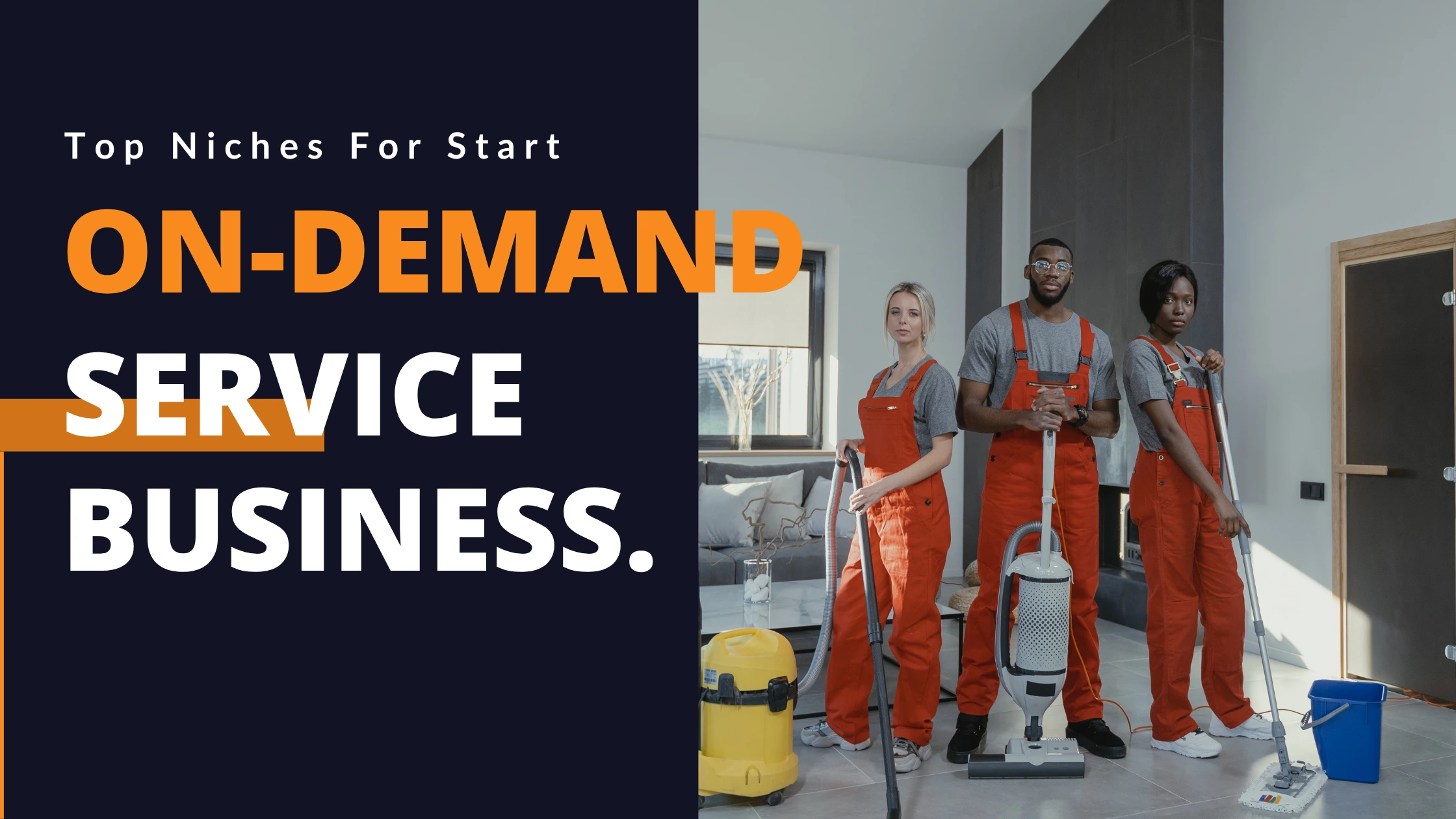Launching an on-demand service marketplace is only half the battle, your real growth depends on the quality and reliability of your service providers. Whether you’re building a platform for home cleaning, plumbing, beauty services, or freelance gigs, onboarding service providers the right way is critical to maintaining service quality, customer trust, and long-term platform success.
In this guide, we’ll walk you through a step-by-step process to recruit, verify, and onboard service providers for your marketplace with confidence. And once your providers are onboard, choosing the right monetization model for your home service marketplace will help you drive sustainable revenue from day one.
Why Provider Onboarding Matters
Before diving into tactics, let’s talk about why this process is so important.
- First impressions count: Your onboarding process sets the tone for how providers interact with your platform.
- Quality control: A structured provider verification system helps eliminate unreliable or fraudulent providers.
- Operational efficiency: Automating parts of onboarding saves your team hours and reduces errors.
Put simply, a clear onboarding framework ensures you attract trustworthy providers who help your brand grow, not harm it.
Step 1: Define Your Ideal Provider Profile

Before you begin onboarding service providers, it’s essential to define exactly who you’re looking for. A clear provider profile acts as your north star when recruiting and verifying candidates. Without it, you risk bringing in individuals who may not align with your platform’s quality standards or customer expectations.
Think of this step as creating a blueprint for your ideal partner one who not only delivers great service but also represents your brand values.
Here are some key attributes to consider when building your provider persona:
Experience and Qualifications
Identify the level of experience and any certifications that are critical for your service category. For example:
- A cleaning platform might prioritize 2+ years of professional cleaning experience.
- A wellness platform might require licensed massage therapists or beauticians with formal training.
- Home repair platforms might require trade licenses or technical certifications.
This ensures that the providers entering your system are not only skilled but also trustworthy from a compliance standpoint.
Availability and Scheduling Flexibility
Consider the type of availability your marketplace needs:
- Full-time vs. part-time providers
- Weekend or evening shifts
- Emergency/on-demand availability
- Support for recurring vs. one-time jobs
Having this clarity helps you match job volume and customer expectations with provider availability, improving fulfillment rates.
Service Area or Geographic Coverage
If your platform operates in specific zones or cities, define:
- Minimum distance a provider must be willing to travel
- Coverage area radius from their home base
- Ability to serve multiple locations (e.g., metro-wide or regional)
A well-defined service area profile avoids location-based cancellation issues and improves customer satisfaction.
Soft Skills and Professionalism
Your providers are often the face of your brand. Look for:
- Strong communication skills
- Politeness and punctuality
- Clean personal appearance (especially for in-home services)
- Ability to handle disputes or complaints calmly
These behavioral attributes may be harder to measure but can make or break your brand reputation.
Tools, Equipment, or Technology Access
Depending on the service type, your ideal provider might need to bring their own:
- Cleaning supplies
- Repair tools
- Grooming kits
- Smartphone for accepting jobs and uploading proof of service
List these requirements clearly to avoid confusion during onboarding.
Step 2: Streamline Your Application Process

A smooth application experience plays a major role in successfully onboarding service providers. If the process is too complex or slow, even qualified applicants might drop off before completing it.
Make it simple, mobile-friendly, and secure. while still gathering the necessary details.
Here’s what to include in your application process:
- Intuitive Sign-Up Form
Keep the form short and well-organized. Only ask for essential information up front such as name, phone number, service category, and city. - Mobile-Friendly Interface
Most providers will apply using their phones. Make sure the application works seamlessly across all devices, with large buttons and clear input fields. - Document Upload Options
Allow providers to upload photos or PDFs of their government ID, business licenses, certifications, or background check clearance directly from their device. - Availability Calendar Input
Let providers set their preferred working hours, days of the week, and availability windows. This helps with automated job matching and scheduling. - Digital Contract Agreement
Include a terms of service or provider agreement that applicants must digitally sign. This protects your platform legally and sets clear expectations from the start.
By making the application process simple yet thorough, you reduce drop-offs, accelerate verification, and ensure you’re capturing the right information to move applicants smoothly to the next stage.
Want a ready-to-launch system that already includes seamless provider sign-up, document uploads, and verification logic?
Check out Prohandy—our full-featured on-demand service platform built with provider workflows in mind.
Step 3: Provider Verification Process

Verification is one of the most critical stages when onboarding service providers. It’s also where many on-demand platforms fall short, either by skipping essential checks or by applying inconsistent standards. A robust verification process ensures your marketplace stays secure, credible, and trusted by customers.
This step filters out unqualified or fraudulent applicants and confirms that every provider meets your platform’s expectations for professionalism and reliability.
Here’s what to include in your provider verification workflow:
- Identity Verification
Require government-issued identification, along with a selfie match or video verification. This prevents impersonation and helps ensure the provider is who they claim to be. - Background Checks
Partner with third-party verification services to run criminal background checks or local record scans, especially for providers who will work inside customer homes or handle sensitive tasks. - License Validation
For regulated services like: plumbing, electrical work, or massage therapy verify licenses or trade certifications. This not only ensures legal compliance but also gives customers peace of mind. - Reference Checks or Work Samples
Collect and review past customer reviews, testimonials, or portfolios of previous work. These real-world signals help assess service quality beyond documents. - Trust Badge or Verified Tag
Once verified, reward the provider with a “Verified” badge on their profile. This visual trust marker boosts confidence for customers and sets verified providers apart from the rest.
Implementing a strong, standardized provider verification system helps you build a dependable provider base essential for scaling your on-demand service platform with confidence.
Step 4: Onboarding & Training

Training is a non-negotiable part of onboarding service providers effectively. Once a provider is verified, they should be equipped with everything they need to succeed on your platform.
A well-structured training flow improves service consistency, reduces support requests, and promotes long-term retention.
Here’s what to include in your provider onboarding and training flow:
- Welcome Guide
Share a simple guide that outlines your platform’s mission, tone, and what sets your service apart. This helps providers align with your brand from day one. - Training Videos or Tutorials
Provide short, step-by-step videos or interactive tutorials that demonstrate how to use the app or provider dashboard, accept jobs, update availability, and communicate with clients. - Service Standards
Clearly define your expectations for punctuality, professionalism, dress code, communication, and service quality. Providers should know what’s expected to maintain active status on the platform. - FAQs and Help Center Access
Give providers access to a knowledge base with answers to common questions, troubleshooting steps, and platform guidelines. This reduces support load and empowers providers to find solutions independently. - Optional First-Time Support Rep
Assign a dedicated onboarding specialist or live support rep for first-time walkthroughs, especially if your platform has complex tools or rules.
To streamline this process, use automated email sequences or in-app notifications to guide providers through each onboarding milestone. The smoother the experience, the faster your providers will be ready to take on real jobs confidently.
Step 5: Go Live with Trial Jobs (Optional but Recommended)

Before fully activating a new provider, consider assigning them a few trial jobs as the final step in onboarding service providers. This helps you test their performance in a real-world setting and gather early feedback.
It also serves as a filter to confirm that only reliable, high-quality providers move forward.
Here’s how to run an effective trial phase:
- Monitor Customer Feedback
Keep a close eye on customer reviews and satisfaction ratings during the provider’s initial jobs. Look for red flags like missed appointments, poor communication, or complaints. - Offer Performance Bonuses
Incentivize strong performance by offering bonuses or priority listing after a successful trial. This motivates providers to start off on the right foot. - Reiterate Platform Policies
Use this phase to reinforce your platform rules, cancellation terms, code of conduct, and dispute resolution processes. This reduces misunderstandings later on.
Trial jobs create a safer environment for both customers and your business. They also help you fine-tune your provider base, ensuring only the most reliable and high-quality service professionals remain active on your platform.
Step 6: Keep Providers Engaged

Onboarding service providers isn’t just about getting them through the application and verification process. it’s about building long-term relationships that lead to consistent, high-quality service delivery. Once a provider goes live, your job shifts from onboarding to engagement.
Engaged providers are more likely to stay active, deliver better service, and advocate for your platform.
Here’s how to keep service providers loyal and motivated:
- Send Regular Performance Reports
Share data on job completion rates, customer ratings, and earnings summaries. This helps providers track their progress and set goals. - Celebrate Milestones
Acknowledge achievements like completing their 50th order or hitting a perfect rating streak. Even small gestures build loyalty and connection. - Provide Incentives
Offer bonuses, badges, or premium placement in the app for high-performing providers. This keeps motivation high and encourages consistent effort. - Keep the Feedback Loop Open
Regularly ask for provider feedback through surveys or one-on-one check-ins. Listening and responding to their input strengthens trust. - Make Continuous Improvements
Update your app or dashboard tools based on provider suggestions. Removing friction shows you’re invested in their success beyond onboarding.
By extending your onboarding service provider strategy into ongoing engagement, you create a provider network that’s not only reliable but also invested in growing with your platform.
Summary
Successfully onboarding service providers is more than just filling out forms or uploading documents. it’s about building a strong, scalable foundation for your entire on-demand marketplace. From clearly defining the ideal provider profile to running trial jobs and keeping providers engaged long after activation, each step plays a vital role in delivering high-quality service and building customer trust.
When done right, a structured onboarding process not only filters out unreliable applicants but also sets your top providers up for long-term success. And in the competitive world of on-demand services, that consistency is exactly what drives growth.
Ready to implement all of this without building from scratch?
Prohandy is a complete on-demand home service marketplace solution that includes provider onboarding, real-time booking, multi-language support, and admin control, perfect for launching your own platform faster and smarter.
Final Thoughts
In today’s fast-moving digital economy, customers expect services that are not only fast—but also professional and reliable. That’s where a solid provider onboarding system becomes your competitive edge. Whether you’re just launching your platform or looking to optimize an existing one, the strategies outlined in this guide will help you maintain service excellence as you scale.
If you’re still in the early stages of building your marketplace, check out our full guide to building an on-demand service business—perfect for founders and product teams who want to get it right from the start.
Want to explore how this trend is shaping global markets? Read more about the power of on-demand services and how platforms are bridging the gap between convenience and quality.
Looking for a tech stack to bring your platform idea to life? We’ve rounded up the best on-demand service marketplace platforms to help you get started quickly and affordably.
Still brainstorming your niche? Discover high-growth opportunities in our list of top on-demand service business ideas that are booming in 2025 and beyond.
A well-executed service provider onboarding process isn’t just a back-end task—it’s a growth strategy. Implement it right, and you’ll see the results in provider performance, customer retention, and long-term platform success.
Frequently Asked Questions
How long should the provider onboarding process take?
Ideally, 1–3 days if automated and streamlined. More complex verifications may take up to a week.
Can I automate provider verification?
What documents should I collect from providers?
National ID, licenses or permits (if needed), bank details for payouts, and signed agreements.
Should I do background checks for every provider?
It’s recommended, especially in services like childcare, home cleaning, or anything requiring in-home visits.
How do I prevent providers from becoming inactive?
Offer incentives, regular job flow, and communication to keep them engaged and motivated.



